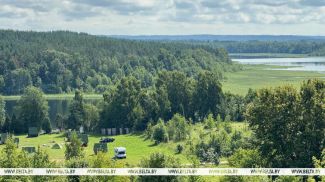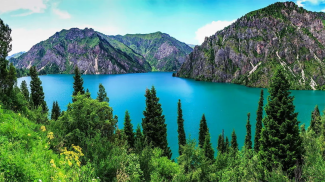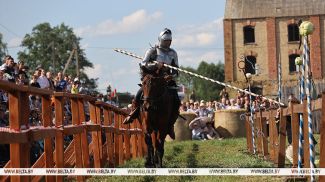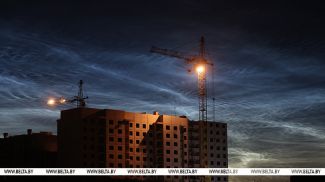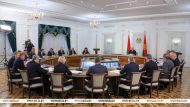What is a patriot and what is patriotism? I think those are people, who create and unite first and foremost. Natalia Ilnitskaya, a business lady from Brest and a member of the Belarusian Union of Journalists, has taken it upon herself to spend her own resources in order to implement a unique patriotic project, which is unparalleled in the European space and the post-Soviet one: she is creating an alley of memory using monuments to Red Army soldiers, who fell in Poland. The monuments were taken down and brought from Europe. Ordinary residents of Polish populated localities spent their own money on setting up these monuments after World War Two as a token of gratitude to the Red Army soldiers, who had saved them from the Nazi. Now the Brest lady saves these obelisks from oblivion and historical forgetfulness.
A series of articles by Alina Grishkevich, a BelTA reporter and a member of the Board of the Belarusian Union of Women, is written in association with the Belarusian Union of Journalists in the Year of People's Unity. The series continues with a short story about Natalia Ilnitskaya. She is a member of the Belarusian Union of Women, a member of the Brest City Council of Deputies, Director General of OOO Laguna, which brand is used to run a hotel complex, a marketplace, a football team, and a TV channel and implement multiple charity projects to support Great Patriotic War veterans, Afghanistan war veterans, people with disabilities, and car rallies. Natalia Ilnitskaya writes the story of her life with love for the Belarusian land, its history, memory about heroic deeds of the ancestors.
Actions make a person unique
The preservation of memory about Soviet heroes became the key deed of today's life for Natalia Ilnitskaya. She is creating an outdoor museum – a Memory Alley – in the agrotown of Mukhavets not far from Brest where every sliver of land is imbued with blood of the fallen Motherland defenders. Her private project unites history of all post-Soviet countries, including Russia, which residents were in Red Army ranks.
This woman is unique due to her passionate patriotism and deeds, which some fail to understand. Particularly now when many are bent on disunity, empty rhetoric, destruction, and blackening of their country…
When Natalia Ilnitskaya came up with the idea, some people tried to chill her enthusiasm by saying it will not work and the dream will remain a dream. However, neither skepticism nor the lack of faith could quench her ardor. Contrariwise, they tempered her desire to achieve the goal. Brest residents know Natalia Ilnitskaya's stubbornness and sense of purpose first-hand.
She was born in Ukraine and lived in Lithuania where her husband served in the airborne troops during the Soviet Union period (he also fought in the Afghanistan war back then). Now Natalia Ilnitskaya works in the Belarusian land, which she has come to love as her motherland. Asked who she is, she responds: I am a Belarusian woman. Her destiny is intertwined with the history of Belarus and Russia, Lithuania and Ukraine as well as other post-Soviet countries.
She has lived in Brest for about 30 years. The land has truly become native for the woman. It has helped her grow as a person, a businesswoman, a patriot, who spends her life to implement the spiritual values she has inherited from her partisan father, mother, grandmothers, and grandfathers.
We met in Mukhavets in the Memory Alley. The place naturally gave start to a conversation about patriotism.
What is patriotism for you?
Patriotism for me is a term, which does not fit specific limits, including a specific timeframe. It is a deeply personal thing for me… Can anyone say that patriotism is only the love of their land? Where does this love start? At what point do you start to understand and recognize this feeling? The love of my parents for each other, their attitude to us, to labor, to other people. All of it shaped me as a person. To be useful to people, to be able to help and support at a time of need. To live not for oneself but for people of one's country. To feel oneself part of the country. Maybe it is what patriotism means for me.
Patriotism is not an empty word for Natalia Ilnitskaya. She has created over 700 jobs and spends profits not only on business development but on helping Great Patriotic War veterans and Afghanistan war veterans because she remembers the Afghanistan past of her husband.
What spiritual values did your mother and grandmother give to you?
I grew up just like all kids of that time. Trust me, our friends and relatives did not teach us anything bad. Honestly speaking, they taught me to protect the weak and to never harm people. In other words, to be a good person.
Is it easy to be a business lady?
Doing business is not an easy thing per se… If it is easy, it is not a business but a hobby. A business of your own always comes with obligations. You undertake responsibility not only for yourself but for the people that trust you. And it is not always easy to bear the trust. Do I think my business is important for local residents? You'd better ask our customers, however, if there are still people willing to buy our products after over 20 years, then there is a demand for them. Services of our hotel are also popular.
Natalia Ilnitskaya took charge of the Laguna TV channel that has become popular with Brest residents. Its target audience is the city dwellers. The TV channel covers her business projects and projects of fellow entrepreneurs, the work of local authorities and the issues that are of interest and concern to local residents.
Natalia Ilnitskaya is quite opinionated about what the state and people should do for each other. The business lady is sure that everyone can and should make a difference in their community.
Memory Alley as life's work
Now her life's work is to perpetuate the memory of thousands of Soviet soldiers and officers who lost their lives liberating European countries from the Nazi invaders. About four years ago monuments to war heroes in some European countries, in particular Poland, ended up virtually in landfills at the stroke of a pen.
Why are you doing this, after all, you could just focus on business?
There is no other way if you have a strong civic stance. How can I turn a blind eye to this situation and just pass by? After all, I am a member of the Brest City Council of Deputies, a member of the Belarusian Union of Women and a member of the Belaya Rus public association. For many years charity has been my way of helping people. If I am able and willing to do it, then why not? You cannot imagine how gratifying it is to realize that you make a difference in someone's life. Every year we hold charity events and concerts to support families with many children, children with disabilities and veterans.
Natalia Ilnitskaya said that one day she watched TV and was horrified to learn that Poland began to demolish WW2 monuments. “I recalled my father who was a partisan; he was badly wounded and his injuries tormented him his entire life. I recalled his stories about the Nazis, who, like beasts, killed, tortured, burned people alive together with their homes. How can one forget it? Witnesses of the war are passing away, their number is dwindling. Monuments, obelisks, literature and artworks, eyewitness accounts are the link between them and the younger generation. Monuments perpetuate human memory,” she said.
What is your take on Poland's handling of Soviet monuments?
I believe that history should be respected and not distorted. Fallen heroes cannot become traitors overnight.
About 20 Polish monuments were relocated to Mukhavets over two years
More than three years have passed since that television report. The work to bring monuments to Brest started two years ago. The work had been preceded by a painstaking and persistent process of approvals and correspondence.
The Polish parliament passed the “decommunization” law in October 2017. Three weeks later Natalia Ilnitskaya started sending letters to the Institute of National Remembrance of Poland and 11 Polish provinces asking for permission to relocate the dismantled monuments to Belarus. Thank God, the Polish authorities did not object.
Before that, she had notified the Belarusian ministries of foreign affairs and culture about her plans. They upheld her noble aspiration and thanked her for her efforts to perpetuate the memory of the fallen heroes who liberated Europe from Nazism.
This private initiative that needs colossal funds is already attracting huge attention domestically and abroad.
Common history of the nations who survived the war
Soviet soldiers liberated Polish towns and villages, saved Polish people from Nazism. Many of our compatriots found their last resting place in the Polish soil, they sacrificed their lives and never returned home leaving a gaping wound in the hearts of their families. More than 75 years have passed since the end of the war, which is just a drop in the ocean of eternity, and all of a sudden the European neighbors decided to shrug it off and erase the memory of Soviet and Belarusian heroes and trample their graves. Over 400 monuments to the heroes of World War II, humble monuments funded by Polish residents, were destroyed and demolished.
It does not matter for Natalia Ilnitskaya who these monuments commemorate - Belarusians, Russians, Ukrainians, Kazakhs, because the history of World War II is the common history of mankind.
Polish monuments in Belarus' Mukhavets
All of the erected 19 monuments and memorial signs from various provinces of Poland are noteworthy. Each had to be assembled literally piece by piece after signing all the necessary documents and then transported to Mukhavets. The restoration work is a separate story, which in fact costs a lot of money. Local specialists are engaged, and they successfully cope with the task, which can be seen by the obelisks and busts that have already been placed on pedestals.
We walk along the alley, where work is still in progress and where there are no paving tiles yet, but there is the main thing, which is the resurrected memory of the heroes - the monuments to them.
The Red Army Commendation Monument from Lidzbark Warminski was the first one to be erected in the Memory Alley in February 2020.
The history of this monument is the following: on 31 January 1945, the troops of the 3rd Belarusian Front under the command of Army General Ivan Chernyakhovsky liberated the town of Lidzbark Warminski in the Varmian-Masiruan Province. A stele in honor of the liberators with the inscription “In Gratitude to the Soviet Army” was set up in the center of the town in May 1949. In 1973, it was supplemented with a sculptural composition of two Soviet soldiers. The monument was dismantled in February 2018 because of its critical condition, and the stele was destroyed to the ground.
When Natalia Ilnitskaya saw it at the demolition site in a terrible condition, broken into pieces, she was first dissuaded from taking it, as the chances of its restoration were extremely poor. The woman, however, was so shocked by the unspeakable tragedy of the Red Army figures embodying heroism and memory, which were left lying on the ground, that she finally took the pieces to Belarus. The fragments of the monument were delivered to Mukhavets in May 2018. The sculptures “came to life” thanks to the efforts of local specialists and now occupy a central place in the Alley of Memory.
The monument to Soviet pilots from Poland's Cielesnica tells the story of the events which took place on 22 June 1941. On the first day of the Great Patriotic War, a Soviet plane that had taken to the air with the task to stop the advance of Hitler's troops into the Soviet territory was shot down by the enemy and crashed near the village outside Biala Podlaska. Both pilots were killed. Paying tribute to the heroism of the Soviet pilots, local residents established in 1968 an obelisk with a red star and a plaque with inscriptions in Polish and Russian: “To the Soviet pilots who died on 22 June 1941 in the battle against Hitler's fascism”.
The pilots' identities are unknown. But there is hope that through the continued efforts of Natalia Ilnitskaya and all those who help her, it may be possible to immortalize their names.
The Soviet Soldiers Commendation Monument was set in the center of the Koden village, Lublin Province in the 1950s to honor the soldiers of the 160th Infantry Division of the 1st Belarusian Front under the command of Konstantin Rokossovsky, Marshal of the Soviet Union, that liberated this Polish town at the end of July 1944. The inscription in Polish on the plaque of the multi-tonne obelisk reads: “To the Soviet heroes who died fighting against the Nazi invaders for the liberation of Koden in 1944. Residents of Koden”. Under the “de-communization” law, the obelisk was demolished in the spring of 2018. It was moved to Mukhavets in the spring of 2020.
There is another object from the same Polish area where Koden is located - a memorial plaque from Zablocie, liberated at the end of July 1944 during the Lublin-Brest offensive by troops of the same 1st Belarusian Front under the command of Marshal of the Soviet Union Konstantin Rokossovsky. As a sign of respect and appreciation for the Red Army soldiers who died fighting the Nazis, the local residents set a memorial plaque with the inscription “To the Red Army Soldiers Who Fell in the Fight for the Liberation of Zablocie, 1944”. In 2018, the monument was pulled down. In 2019 it was delivered to Belarus to be restored and occupy its place in the Alley of Memory in the summer of 2020.
We move further along the Memory Alley and see an obelisk from Strzelce Krajenskie, which was erected by residents of the Polish town in 1954 at their own expense to pay tribute to the soldiers of the 1st Belarusian Front of the Red Army under the command of Marshal of the Soviet Union Georgy Zhukov. The soldiers died in the battles for the liberation of the town in January 1945. The red granite plaque has the following inscription: “To the heroes of the Red Army, fallen in the battles for the liberation of the Polish people. Strzelce Krajenskie Community”.
The Monument to Soviet Prisoners of War unites two obelisks honoring the Soviet prisoners of war who worked and died from starvation and torture in German concentration camps. There is a red star in the upper part of the monument. In the lower part there is a plaque with the inscription: “The place sanctified by the blood of the Soviet citizens, taken prisoners and brutally murdered by the Nazi invaders in 1942-1944. Eternal memory to them. Radom Community on the 20th anniversary of the establishment of the PRL (Polish People's Republic)”. The remains of the obelisk destroyed as part of the “decommunization” work were discovered near the town of Radom, Masovian Voivodeship in 2018.
We can also study the history of Poland's liberation with the help of certain monuments. Let's take, for example, the stele from the city of Radom in the southeast of Poland, 100km away from Warsaw. The city was liberated on 16 January 1945 by the forces of the 1st Belorussian Front. As many as 2,675 Soviet soldiers died in the battles for the city. The stele was installed in honor of their memory. The tablet on the monument says: “Here lie the Red Army soldiers who died in the battles against the Nazi invaders during liberation of the city of Radom on 16 January 1945. Eternal glory to the heroes”.
The alley also features a monument from Trzebieslawice. This concrete monument was built by the Poles five years after the war. The memorial tablet says: “To the heroes of the Red Army, liberators of the Polish nation. From residents of Trzebieslawice. 1945”.
There are monuments that were erected by grateful Poles dozens of years after the war, which demonstrates that the nation remembers the liberators. For example, the monument of Gratitude to the Red Army in Dubicze Cerkiewne of Hajnowka County was installed by local residents on 9 May 1985. The monument represents a concrete foundation with a figure of a Soviet soldier calling to battle. The monument was created with the help of a participant of the war – solider of the Red Army Dmitry Moskalenko. As many as 452 soldiers of the 1st Belorussian Front under the command of General Konstantin Rokossovsky died in the battle for the city in the summer of 1944.
Many visitors of this open-air museum take interest in the memorial slab from Rogoznik. It was installed in the south of Poland in 1987 to commemorate the Soviet soldiers who liberated the city in January 1945, after bloody battles. The concrete slab bears the engraved words: “To the fallen soldiers of the Soviet army. From local residents”. The slab was one of the last memorials to the Red Army soldiers created in Poland.
The memorial slab Star is a symbol of the Great Victory of the Soviet nation and the Red Army over Nazism in World War II of 1939-1945 that caused unfathomable human losses: around 72 million people. A third of them – 27 million – were from the Soviet Union. Belarus lost a third of its population in the war.
Another interesting fact is that the museum in Mukhavets features the bust of Karol Swierczewski – a participant of World War I, the October Revolution, the Russian Civil War, and the Spanish Civil War, one of the organizers of the Polish People's Army in the territory of the Soviet Union, commander of the Polish Second Army as part of the 1st Ukrainian Front since August 1944. Since 1946, he worked as the Polish deputy minister of defense, since 1947 he was a member of the parliament. Karol Swierczewski was killed by the Banderites in 1947. This bust was dismantled in Poland and the authorities permitted to move it to Belarus.
Almost all these and other monuments were dismantled in Poland in 2017-2018 and brought to Mukhavets in 2019-2020, where they were renovated and installed in the Memory Alley in the open-air museum.
This unusual place draws residents of other Belarusian regions as well as Russian military servicemen and visitors from other countries.
School students are special guests. They not only look at the exhibits, but also bombard the museum guide, an experienced historian, with questions about the history of their country, Poland, and Europe. When they look at the monuments and read the words engraved on them, they learn about this heroic and tragic page in the history of their nation.
Natalia Ilnitskaya is keen to continue saving monuments to heroes from oblivion
The tragedy of the Great Patriotic War is commemorated in the monuments of the Brest Hero Fortress Memorial Complex. The Memory Alley in Mukhavets is becoming another piece in the common history of heroism of the Soviet nation, including Belarusians.
“This project is very dear to me. Of course, I would like to go ahead with it in the memory of my grandfathers who fought in the Great Patriotic War and all heroes of those dreadful years. We will collect as many monuments as we can,” Natalia Ilnitskaya noted.
Answering the question about her family's attitude to her work, she answered: “They fully support me.”
What is your dream?
“I am an active person. I have short-term dreams, for example, to finish the construction of the business center. Other dreams are more distant – the Memory Alley that fully occupies my thoughts. I dream to make this a place of pride in the deed of our soldiers, an example for the new generations.”
What do you like doing the most?
“I like working and helping people. It is important to aspire not only to material, but also to spiritual values. You can earn people's respect only with good deeds. If you want something, you will find the way to do it. If you work, achievements will not be long in coming.”
On 8 May, in the run-up to Victory Day, Natalia Ilnitskaya together with members of the Belarusian Women's Union from Brest intends to organize another motor rally. The main destinations of the route will be the Brest Fortress, mass graves of Red Army soldiers, and Natalia Ilnitskaya's Memory Alley.
By Alina Grishkevich
BelTA




